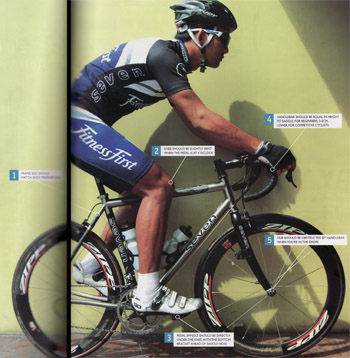5 Tips for Perfect Bike Fit
Words by Joel Gironella
Athlete: Eric Carandang, fitness first cycling team

My wife often jokingly tells our friends that I log more miles on my bike than with my car. And although there is some truth to that, doing a 65-km bike ride for two hours is certainly a much more pleasurable experience than having to drive from Alabang to Mandaluyong in a similar time and see your odometer advance by just 40-kms. Since I put in major time on my bike, I make sure that I’m properly fitted and comfortable riding it. A poorly fitted bike position can spell disaster for mist beginners. Ailments can range from a sore neck, numb feet, lower back pain or worst…saddle sores…Ouch! Her are a few pointers to consider to make sure that you’re properly dialed in.
1. Frame Size
Nothing is more crucial than buying the correct bike frame size. With most manufacturers making their sizing as simple as buying a t-shirt, it’s imperative that you consult your local bike shop on what’s your ideal frame size based on your bodily proportions (arms, legs, torso…). If you get this part wrong, you’ll have a hard time following the other pointers.
2. Saddle Height
Start pedaling, and with your leg all the way down (pedal in 6 o’clock position), you should see a slight bend in the knee. If your leg is straight (knee locked), your seat is too high. If your knee is very bent, then your seat is too low. Either way, both problems can hurt your knees. A seat that’s too high will also cause you to bob on the saddle, causing you to waste too much energy stretching out your legs to compensate the pedal stroke. On the other hand, a seat that’s too low won’t utilize all your leg muscles.
3. Seat Position
The nose of the your saddle should be behind the bottom bracket (the axle that’s turned by your crank arms). If it’s ahead of the bottom bracket, you won’t be fully utilizing your leg muscles. You want to have as smooth a pedal stroke as possible. Also, with the pedals parallel to the ground, your front knee should be directly over the pedal spindle (middle of the pedal). The idea with your pedal stroke is to make it semi-elliptical (not circular as is the common misnomer). You want the achieve a smooth application of power on the downstroke, and a seamless pull of you leg on the upstroke.
4. Handlebar Height
For beginners, your handlebars should be ideally equal in height to your seat. For the competitive cyclist who wants to be more aerodynamic, then a handlebar height which is lower by three to five inches than the seat height is ideal. The more flexible you are, the more aerodynamic you can be without sacrificing comfort. Yoga practitioners have a definite advantage here. Note that a lower handlebar height tends to compromise breathing; there’s a limit to how low you can go before you literally find it difficult to breathe.
5. Stem Length
To determine if you have the proper (the bar that links your handlebar to the frame), just grip the drop portion of your handlebar and look downwards. As a rule of thumb, you should not see the hub of your front wheel. It should be obstructed by the the top of the handlebar. If you can see it ahead of the handlebar, then your stem is too short. If the hub is far behind your handlebar top, then your stem is too long.
By following these five basic bike fit principles, you can be assured of hours of fun and comfort in your bike, not to mention an injury—and pain-free experience as well. See you all on the road!
